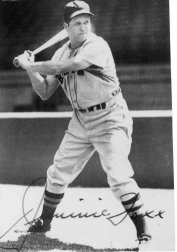
WHAT IF TED AND MICKEY
HAD BEEN ON THE JUICE?
By John B Holway
As Barry Bonds closes in on Babe Ruth's 714 home runs, one wonders how many the Babe or Mickey Mantle would have hit if they had been on steroids.
Imagine Ted Williams, "the Splendid Splinter," as a hulking 250-pounder with a torso like the Michelin tire cartoon man.
 Or What about Boston's Jimmie Foxx, who
for years was second only to Ruth until Willie Mays passed him in 1966. Even
without steroids, Jimmie looked like Arnold Schwartzeneger. "Even his hair
had muscles," Yankee pitcher Lefty Gomez winced. (Why haven't the Red Sox
retired Foxx's #3?)
Or What about Boston's Jimmie Foxx, who
for years was second only to Ruth until Willie Mays passed him in 1966. Even
without steroids, Jimmie looked like Arnold Schwartzeneger. "Even his hair
had muscles," Yankee pitcher Lefty Gomez winced. (Why haven't the Red Sox
retired Foxx's #3?)
________________________________________________________
John B Holway's next book, TED, the Kid, will be published in July.
Ruth is officially listed at 212 pounds, though he probably weighed more at his beer-bloated end. Mickey tipped 210. Jimmie weighed only 185. Ted broke in as a rookie at 175, dripping wet. They would all look puny standing next to Mark McGwire or Bonds, at 240 or more.
According to the San Francisco Giants, Bond's longest home run sailed 491 feet. Ruth, Mantle, Foxx, and Ted all blasted several 500-footers, using only the muscles Mother Nature gave them.
Williams' longest may have come in his rookie year, 1939, on May 4 in Detroit.
 Briggs (later Tiger) Stadium
was sporting a new roof over the second deck in rightfield, 94 feet above
the field and 318 feet from home. As Ted stepped in against right-hander
Roxie Lawson (4-8), Boston's hare-lipped Jim (Sarge) Bagby tried to wave
Tiger first baseman Hank Greenberg to play deeper "if you don't want to talk
like me."
Briggs (later Tiger) Stadium
was sporting a new roof over the second deck in rightfield, 94 feet above
the field and 318 feet from home. As Ted stepped in against right-hander
Roxie Lawson (4-8), Boston's hare-lipped Jim (Sarge) Bagby tried to wave
Tiger first baseman Hank Greenberg to play deeper "if you don't want to talk
like me."
Greenberg ignored him, and Williams unloaded one far over Hank's head into the stands, his second big league homer.
"I hope that guy is still pitching the next time I come up," Ted told Rudy York the native-American catcher, as he crossed home plate. "I'll knock it clear over the roof."
Doc Cramer, who was on base, waited for him at home. "You hit that one pretty good," he said.
"Yeah," Ted said, "and next time I'm going to hit one over the top of it."
The next time up, two men were on, rookie Bob Harris
(4-13) was pitching, and the count ran to 3-0. "You're not hitting, are you, Kid?" York asked.
"Yes, I am," Ted answered. A fat "cripple" came in, and he smashed it into the upper deck -- foul.
"I'm still hitting," he warned York, then blasted the next pitch over the new roof, the first man ever to do it. It wouldn't be done again for 18 years, until Mantle in 1957. As Ted rounded first, Greenberg was still gaping at the spot where the ball had disappeared.
As Ted passed third, Billy Rogell asked, "What the hell you been eating, Kid?"
As he touched home, York welcomed him: "You weren't kiddin', Kid, were you?"
The Detroit crowd gave the Kid a thunderous ovation. Did he tip his cap? It isn't reported, but he says he tipped it a lot that wonderful rookie year, lifting it, not by the visor, but by the button on top.
How far would it have gone if it hadn't hit the roof?
A simple rule of aerodynamics will solve the problem. I went to Francis Mirabelle, a scientist at the Army's Missile Proving Grounds in Aberdeen Maryland, who told me that any missile, whether an artillery shell or a baseball, will reach its zenith at 60 percent of its total distance. (On the airless moon, it's 50 percent). The height doesn't matter, only the distance to the highest point. (Contrary to conventional wisdom, the optimum angle is not 45 degrees, it's about 32 in the earth's atmosphere.)
Assuming that Williams' shot was at its maximum height when it soared over the roof, then the formula is 6 / 10 = 318 / x. Therefore, x = 530 feet, unimpeded.
If it had begun its descent, the distance would have been less; if it was still going up, the ball would have traveled farther.
In other words, the 175-pound Kid powered the ball three feet per pound.
Compare that to Bonds or McGuire, whose longest shots went two feet per pound.
How far would Ted have blasted it if he had weighed as much as they did, that is, 240-250 pounds? You do the math. I get 720 to 750 feet.
Mickey's hardest drive hit the facing of the old roof at Yankee Stadium about 400 feet from home. (Since the roof was 100 feet above the field, the trajectory would have been just about 32 degrees.) Assuming that the ball was at its maximum height on impact, then I get a total distance, unimpeded, of 620 feet, or also three feet per pound. If Mick had been on the juice and had bulked up to 240 like Barry, his fabled shot would have traveled 700 feet.
Incidentally, Ted's Detroit shot was also the first one Williams called in the big leagues - the second one overall, if you count one in high school. In all, I have counted 17 called shots for him, compared to two by Ruth. That must be another record.